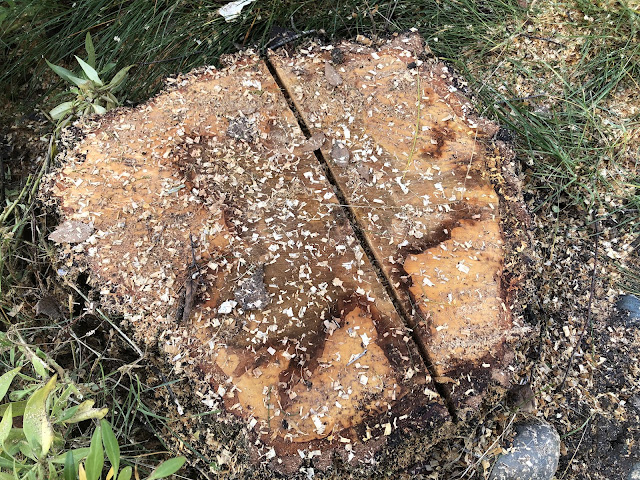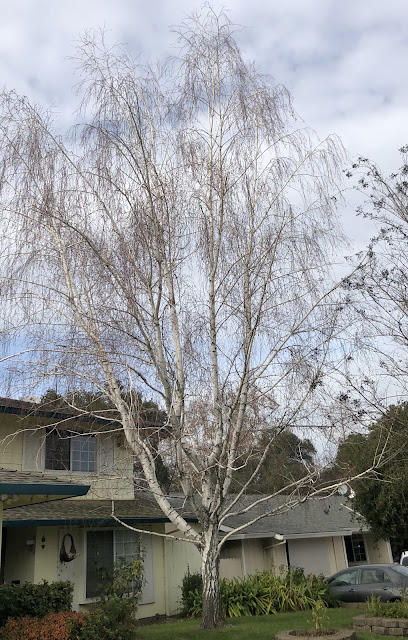
Birches aren't drought-tolerant and other things to know

|
|
This stump is all that's left of the fifth and last birch tree in my yard. (Photos:
Kathy Morrison)
|
The last of the five birch trees that were in our front yard bit the dust Wednesday. The tree crew took just 45 minutes to fell it, the branches hitting the muddy lawn with a loud "thud" as they were cut off.

|
|
Birches are prized for their white bark but
the branches can be brittle.
|
But the fifth tree was on the opposite side of the yard, the southern side, and it did a great job shielding some of the garden and house from the afternoon sun. (Of course it also dropped tons of small leaves in the fall.) The squirrels used it as part of their arborial highway, and the scrub jays often sat in the upper branches, keeping watch against predators while their nestlings slept in the nearby fern pine tree.
It takes a long time to kill a tree, so I think the big California drought of 2011-2017 spelled the eventual doom of this birch tree.

|
|
This birch tree in a Carmichael neighborhood looks healthier
than the one we had removed this week. |
My current neighborhood was built between 1962 and 1970, and some stands of birches remain, but they are looking their age. And people still plant them -- a house a block away has two relatively young trees growing right in the lawn.
Tree fans contend that there are no bad trees, only bad tree locations, and I'm inclined to agree.
Here's the truth of the matter: Birches are natives of very cold climates. They need moist soil, and their shallow, wide-spreading roots are vulnerable to heat and drought. That makes the white birch one of the worst trees you can plant in drought-prone California. The aphids, of course, are another issue.
This last birch put out roots under most of our front lawn, but the irrigation cutbacks were clearly hurting it. The leaves this past year were much sparser than in past seasons, and a few of the branches in the crown didn't have leaves at all. My neighbor was afraid it was going to fall on her house -- though it wasn't leaning -- so we had our favorite arborist come look at it.
He agreed that the tree was slowly failing and could lose the top in a heavy windstorm. Birches in our climate, he noted, have a life span of 15 to 20 years or so. And this tree was at least 25, probably more. He said we could have it topped or have it removed. I've seen a few pathetic topped birches in the neighborhood, and I didn't want that.
So down it had to go, and yesterday it did.
The yard seems more exposed, so I probably will plant some shrubby native perennials in that area, but not another tree. There are utility lines buried nearby and I don't want to chance disturbing them.
If you have a birch in your yard, keep a close eye on it. And while you're at it, get to know the other trees around you, to forestall future questions. A tree that doesn't match our climate can survive -- with extra care.
But natives and other low-water trees are better choices. The Sacramento Tree Foundation site is an excellent place to start learning about these, with loads of information on trees for local landscapes. It also has information on how to hire an arborist.
Comments
0 comments have been posted.Sacramento Digs Gardening to your inbox.
Food in My Back Yard Series
April 1: Don't be fooled by these garden myths
March 25: Fertilizer tips: How to 'feed' your vegetables for healthy growth
March 18: Time to give vegetable seedlings some more space
March 11: Ways to win the fight against weeds
March 4: Potatoes from the garden
Feb. 25: Plant a fruit tree now -- for later
Feb. 18: How to squeeze more food into less space
Feb. 11: When to plant? Consider staggering your transplants
Feb. 4: Starting in seed starting
Sites We Like
Garden Checklist for week of March 30
Your garden doesn’t mind April showers. Get busy now to enjoy those future flowers.
* Get ready to swing into action in the vegetable garden. As nights warm up over 50 degrees, start setting out tomato, pepper and eggplant transplants.
* From seed, plant beans, beets, cantaloupes, carrots, corn, cucumbers, melons, pumpkins, radishes and squash. (Soak beet seeds overnight in water for better germination,)
* Plant onion sets.
* In the flower garden, plant seeds for asters, cosmos, celosia, marigolds, salvia, sunflowers and zinnias.
* Transplant petunias, zinnias, geraniums and other summer bloomers.
* Plant perennials and dahlia tubers for summer bloom.
* Transplant lettuce and cabbage seedlings.
* April is the last chance to plant citrus trees such as dwarf orange, lemon and kumquat. These trees also look good in landscaping and provide fresh fruit in winter.
* Smell orange blossoms? Feed citrus trees with a low dose of balanced fertilizer (such as 10-10-10) during bloom to help set fruit. Keep an eye out for ants.
* Apply slow-release fertilizer to the lawn.